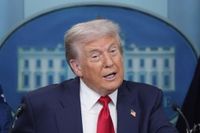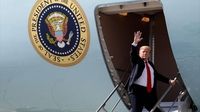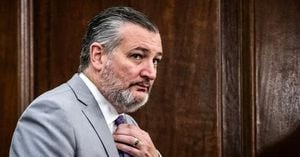In a decision that has sent shockwaves through the international aid community, the U.S. Court of Appeals for the District of Columbia Circuit ruled this week that the Trump administration can move forward with suspending or terminating billions of dollars in congressionally approved foreign aid. The ruling, delivered on August 13, 2025, marks a pivotal moment in the ongoing battle over the executive branch’s authority to control federal spending, especially as it relates to humanitarian efforts abroad.
The controversy began on January 20, 2025, the first day of President Donald Trump’s second term, when he issued an executive order instructing the State Department and the U.S. Agency for International Development (USAID) to freeze foreign aid spending. The administration argued that a temporary pause—initially set for 90 days—was necessary to ensure that federal grants and loans were aligned with its policy goals and to address what it viewed as excessive expenditures.
This abrupt halt in funding, however, triggered a global crisis in the humanitarian aid sector. Nonprofit organizations and grant recipients, whose work depends on the steady flow of U.S. foreign assistance, quickly mobilized to challenge the executive order in court. Their lawsuit focused on billions of dollars already appropriated by Congress for the 2024 budget year, including nearly $4 billion earmarked for global health programs and more than $6 billion dedicated to combating HIV and AIDS worldwide, as reported by the Associated Press.
In March 2025, U.S. District Judge Amir Ali sided with the grantees, issuing a temporary restraining order that blocked the Trump administration’s suspension of funds. Judge Ali’s ruling mandated the release of the full amount of foreign assistance as appropriated by Congress, at least until the legal questions could be resolved. The administration, however, appealed the decision, setting the stage for a high-stakes showdown in the appellate courts.
On August 13, 2025, the D.C. Circuit Court delivered its 2-1 decision, with Judges Karen LeCraft Henderson and Gregory Katsas forming the majority. Both judges—appointed by Presidents George H. W. Bush and Donald Trump, respectively—concluded that the plaintiffs, primarily nonprofit organizations and grant recipients, did not have the legal standing to press their claims under the Impoundment Control Act. According to the majority opinion, only the head of the Government Accountability Office is authorized to sue under this statute. "The district court erred in granting that relief because the grantees lack a cause of action to press their claims," the judges wrote.
The ruling did not address the underlying constitutional question—whether the executive branch’s actions unlawfully infringed on Congress’s exclusive spending powers. Instead, the court sidestepped the issue, focusing solely on the legal technicalities of standing and the requirements for a preliminary injunction. As Judge Henderson explained, "The parties also dispute the scope of the district court’s remedy, but we need not resolve it ... because the grantees have failed to satisfy the requirements for a preliminary injunction in any event."
Judge Florence Pan, appointed by President Biden, issued a sharply worded dissent. She argued that the majority’s decision ignored the fundamental principle that the president cannot disobey laws for policy reasons, a doctrine she said the Supreme Court has upheld "in no uncertain terms." In her dissent, Judge Pan wrote, "Yet that is what the majority enables today. The majority opinion thus misconstrues the separation-of-powers claim brought by the grantees, misapplies precedent, and allows Executive Branch officials to evade judicial review of constitutionally impermissible actions." Judge Pan further warned that such judicial acquiescence "derails the carefully crafted system of checked and balanced power that serves as the greatest security against tyranny—the accumulation of excessive authority in a single Branch."
The stakes of the decision extend far beyond the courtroom. According to research published in July 2025 in The Lancet, the Trump administration’s decision to cut the majority of U.S. financing for international humanitarian relief could result in an additional 14 million deaths by 2030. The study’s co-author, Davide Rasella, noted that children account for one-third of those at risk of dying young. The report described the shock experienced by low- and middle-income nations as "comparable in scale to a global pandemic or a major armed conflict."
The humanitarian consequences are already being felt. In March 2025, U.S. Secretary of State Marco Rubio announced that USAID had cancelled more than 80% of its programs. These cuts, which the Trump administration has repeatedly justified as necessary to rein in what it considers excessive foreign spending, have left aid organizations scrambling to find alternative sources of funding—or, in many cases, forced to shutter operations altogether.
Critics of the administration’s actions argue that the cuts not only undermine America’s longstanding commitment to global health and development, but also risk destabilizing regions already facing significant challenges. Many experts warn that the loss of U.S. funding for HIV prevention, vaccination campaigns, and food security initiatives could reverse years of hard-won progress, particularly in vulnerable communities.
Supporters of the Trump administration’s stance, on the other hand, maintain that the United States must prioritize its own interests and ensure that taxpayer dollars are not wasted on ineffective or misaligned programs. They argue that the executive branch has a responsibility to review and, if necessary, suspend federal spending that does not serve the nation’s strategic objectives. As one administration official put it, "We cannot continue to write blank checks for programs that don’t deliver results or align with our values."
The legal battle over foreign aid funding is far from over. While the D.C. Circuit’s decision clears the way for the Trump administration to proceed with its cuts, it leaves unresolved the broader constitutional question of whether the executive branch can override Congress’s explicit spending directives. Some legal scholars expect that issue to eventually reach the Supreme Court, especially given the dissenting opinion’s strong language about the separation of powers.
For now, the immediate impact is clear: billions of dollars in U.S. foreign aid are at risk, and millions of lives hang in the balance. As policymakers, aid workers, and affected communities grapple with the consequences, the debate over America’s role in the world—and who gets to decide how its resources are used—shows no sign of abating.
As the dust settles on this latest chapter, the fate of U.S. foreign assistance remains uncertain, shaped as much by legal wrangling in Washington as by the needs of those on the ground.





